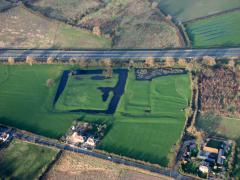
News Archive
Records of Bucks is going on-line
1 September 2010
Though not all at once, of course. After 152 years of publication, the society’s annual journal has put into print around 22,000 pages of learned articles on the history, architecture and archaeology of Buckinghamshire. Rather too many even for the Internet to swallow in one go!
But on 1 October this year the society will start a rolling programme of on-line publishing which will eventually put all back numbers of the journal on-line, making our accumulated knowledge of the county available worldwide.
For on that day we will launch the on-line version of Records volume 11, which was originally published in six parts between 1919 and 1926, most of them out of print for some time. The programme then aims to publish on-line a new volume every six months, giving priority to those that are out-of-print.
For on-line publication, the original printed volumes have been scanned and electronically processed. This gives ‘the best of both worlds’. The on-line version of each article is therefore a facsimile – avoiding retyping with its inevitable accidental insertion of spelling errors (though preserving any in the original!) – yet can also be searched electronically by keyword. The articles will also be accessible from the BAS website both directly from the Articles Index, and indirectly through the searchable Subject Index.
This will give readers and researchers three separate ‘lines of approach’ to the On-line Records, making the historical detail in each article academically fully accessible.
To say that the contents of On-line Records 11 will offer ‘something for everyone’ may seem a cliché, but they certainly make us aware of the richness of the ‘intellectual property’ that our society has accumulated during its 152 years.
For documentary historians there are transcriptions not just of parish records but the county’s Archdeaconry Courts and the ‘Oath Rolls’ of 1696. Beyond this, however, the journal itself offers a primary source in its own right: the 1919 Annual General Meeting was told that ‘The maintenance of the Museum alone, with the strictest economy, cost £150 per annum’ and the Museum’s Acquisitions that year included: ‘RAT (albino) Mus decumanus = Epimys norvegicus ... caught in Aylesbury (Police-Sergt. Fennimore).’
For archaeologists there are excavation reports of a Roman burial at Radnage and an Iron-Age enclosure at Bulstrode. The object of that at Danesborough Camp was ‘to ascertain, if possible ...Whether the popular attribution of the “camp” to the Danes is correct, or not.’ The author reports that this problem was ‘solved’.
For architectural historians there are notes on many historic buildings, some of which have since disappeared, among which the most interesting are the building accounts for Winslow Hall. So was it designed by Sir Christopher Wren? Read the accounts and see whether you can decide...
Whatever your special interest, go to the Articles Index for Records volume 11 on Friday 1 October - and join the Records of Buckinghamshire on-line.
PETER MARSDEN
How old is that house?
A one-day workshop in Wingrave open to all-comers
1 September 2010
Dating historic houses is a puzzle. There are obvious clues (does the building have a jointed oak frame?) but also pitfalls (is it really 16th-century or a clever Arts and Crafts copy?). Come to Wingrave to follow the clues and, hopefully, avoid the pitfalls, for a day when we’ll be looking at and dating a series of local buildings from medieval to modern.
Is the dating of historic buildings an art or a science? Dendrochronology – the dating of timbers by their tree-rings – offers a scientific approach, but brings its own set of pitfalls. We’ll be exploring this with the help of dendrochronologist Andy Moir, who will be taking core samples from one or more houses on the day. But we’ll also look at how changing building styles and features, both structural and artistic, can ‘map’ a historic building – how the artistic approach may succeed where science fails.
This One-day Workshop is on Saturday 9 October, 10am to 4pm, at the Wingrave Methodist Schoolroom, next to the Methodist Church in Nup End Lane (Wingrave is six miles north-east of Aylesbury). The cost is £5.00, payable in advance to cover room hire, tea, coffee and other refreshments. Bring your own lunch.
Book your place now by sending a cheque for £5, made payable to ‘BAS’, to Peter Marsden, Buckinghamshire Archaeological Society, County Museum, Church Street, Aylesbury HP20 2QP. More information from the organisers: Andrew Muir (Wingrave) 01296 681513 or Peter Marsden (BAS Historic Buildings Group) 01296 696303.

Medieval moated site at Aston ClintonNew County Book out 6th March 2010
10 February 2010
An Illustrated History of Early Buckinghamshire covers from the Ice Age to the Tudors. This pioneering, generously illustrated book, brings together seven authors with special knowledge of early Buckinghamshire who build an up-to date picture of the intriguing past of this historic county. The chapters draw on the many new discoveries made by archaeologists and other experts as well as members of the public. Inside you will meet mammoths, early prehistoric farmers, Romans, Britons, Saxons, Vikings, Normans and medieval peasants all of whom have left their mark on the Buckinghamshire landscape.
(240 pages including 135 colour figures. ISBN Number 978-0-9558158-4-3)
The book can be purchased through the society for £15.99 (plus postage - £2.50 to UK addresses). Click here to contact the society for further details.
|